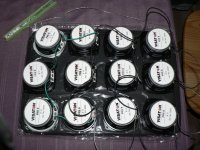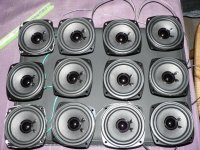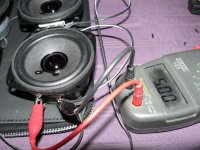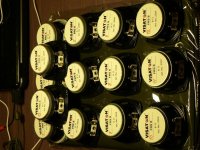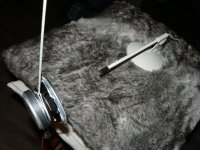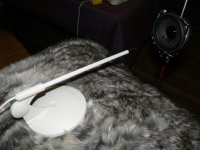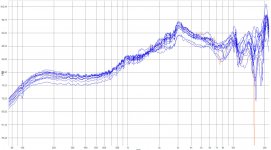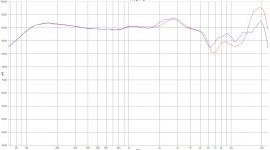Hello,
I played around with some measuring on the 14 FRS8 drivers I have laying in storage for way to long.
10 of them will be used for 5 enclosures.
These aren't high end drivers and the only thing I want to do is try and pull the SPL up a bit, starting at 80hz. I'm thinking bass reflex?
Around 3.2khz there is a rise in response that needs to be suppressed at least 6dB (I think...) starting at 2khz until about 6khz
I really could use some help with the filter!
The impedance at 3.2khz is 9.5Ω
Pics taking while 'braking in' the small drivers at 5V with brown noise and the setup for measurement, 10cm (4") distance to mic.
Are there other things to consider?
There is one driver that surprised me; a huge sharp narrow dip at 15830hz, what can cause this? (orange curve)
Thanks.
Bart.
I played around with some measuring on the 14 FRS8 drivers I have laying in storage for way to long.
10 of them will be used for 5 enclosures.
These aren't high end drivers and the only thing I want to do is try and pull the SPL up a bit, starting at 80hz. I'm thinking bass reflex?
Around 3.2khz there is a rise in response that needs to be suppressed at least 6dB (I think...) starting at 2khz until about 6khz
I really could use some help with the filter!
The impedance at 3.2khz is 9.5Ω
Pics taking while 'braking in' the small drivers at 5V with brown noise and the setup for measurement, 10cm (4") distance to mic.
Are there other things to consider?
There is one driver that surprised me; a huge sharp narrow dip at 15830hz, what can cause this? (orange curve)
Thanks.
Bart.
Attachments
For surround, I'd consider spreading the 4 extra drivers around, maybe have 4 drivers on the front L/R, and 2 in the rest.
You won't need to worry much about the rising response to ~3kHz - remember that you measured them with no baffle or cabinet, so dipole cancellation will occur below 3kHz, resulting in much reduced output (as is seen in the graph).
You won't need to worry much about the rising response to ~3kHz - remember that you measured them with no baffle or cabinet, so dipole cancellation will occur below 3kHz, resulting in much reduced output (as is seen in the graph).
Nice idea on the extra drivers for the front L/R! 
But then I'm down to 8Ω again. Still beneficial? Is it as simple as putting the front L/R at +3dB?
In the graph I see a drop in respons from 3khz on up too, that does let me worry a bit.
When measuring at 1cm, the peak is there too
Thanks.
But then I'm down to 8Ω again. Still beneficial? Is it as simple as putting the front L/R at +3dB?
In the graph I see a drop in respons from 3khz on up too, that does let me worry a bit.
When measuring at 1cm, the peak is there too
Thanks.
Suggestions on the notch filter? anyone?
A simple bass reflex box would be nice to pull up the 80hz region but I see the box becomes quite large for two and even larger for four drivers
Closed box is the best option but then it doesn't reach as low as I want.
What's the best compromise?
A simple bass reflex box would be nice to pull up the 80hz region but I see the box becomes quite large for two and even larger for four drivers
Closed box is the best option but then it doesn't reach as low as I want.
What's the best compromise?
In my room that will not work well and I can't point them to a certain direction just because of the wall mounting, flat on the wall.
The placement of the TV is not optimal so I'll have to be able to point the boxes in certain directions.
And I will use two drivers in the enclosures, probably four in the front L/R.
I don't think it can be done in existing small tapped horn's like a Needle...?
The placement of the TV is not optimal so I'll have to be able to point the boxes in certain directions.
And I will use two drivers in the enclosures, probably four in the front L/R.
I don't think it can be done in existing small tapped horn's like a Needle...?
I played around with some measuring on the 14 FRS8 drivers
I think this is interesting, why we see 5 dB variance between the drivers across the full freq band ? Are the measuremnt conditions absolutely the same for each driver ?

I agree, this was just to show the bump around 3khz, for which I want a notch filter. I don't like shouting speakers.Target enclosure should be built/mocked up and driver measured mounted for crossover/EQ determination. IMO, 1/6th octave smoothing hides too much detail.
Do you suggest I build a BR and then measure again?
Should the port be in the back or near the driver?
What model of microphone is that? Has it been compared to a standard, or do you have a "calibration" curve for it?
Neat experiment, nonetheless. We love data.
The MC1 microphone does not need correction from 20hz to 20khz.
ATB PC Pro Audio analyzer PC measurement test-DVD CD speaker SPL THD RTA developement setting
I can do measurements on request if necessary.
An externally hosted image should be here but it was not working when we last tested it.
The conditions are all the same, the distance couldn't have deviated more then half a cm. This was tricky because the drivers hung from the ceiling on a thin wire about 1.5m long.I think this is interesting, why we see 5 dB variance between the drivers across the full freq band ? Are the measuremnt conditions absolutely the same for each driver ?
I'm doing the same with the T&S parameters and they deviate quite a bit too, but these are cheap drivers, didn't expect consistent results anyway.
This is why I measure them all. This way I can pair them (or 4) by the results. I want to pair two drivers with as much difference, in the high frequency's, as possible.
Suggestions on the notch filter? anyone?
A simple bass reflex box would be nice to pull up the 80hz region but I see the box becomes quite large for two and even larger for four drivers
Closed box is the best option but then it doesn't reach as low as I want.
What's the best compromise?
Parallel Notch Filter Designer / Calculator Help
T/S specs?
Regardless, seems like a closed box and digital EQ is called for now that both power and electronics are relatively cheap.
GM
Nice idea on the extra drivers for the front L/R!
But then I'm down to 8Ω again. Still beneficial? Is it as simple as putting the front L/R at +3dB?
In the graph I see a drop in respons from 3khz on up too, that does let me worry a bit.
When measuring at 1cm, the peak is there too
Thanks.
I don't expect you'll need to change the settings on the receiver: adding drivers in series means less power going through (assuming equal voltage into the group), but more cone area. The voltage sensitivity ought to remain equal, but of course current flow is smaller, so each driver sees less power => less distortion.
From memory, those drivers are fairly good. I don't expect you'll have any problems with vocal intelligibility etc.
For a really quick-and-dirty test, rig them up in cardboard.
http://www.diyaudio.com/forums/full-range/154982-thought-id-share-cardboard-u-frame.html
Use something like Foobar2000 (or even iTunes) to apply some bass boost.
You might find that adding an inductor to one of the drivers improves things, as comb filtering etc would be avoided, and BSC (once in a cabinet) taken care of.
Chris
I won't use digital EQ since there will be 5 of these boxes and would be to expensive compared to the cost of the drivers (12€/pc)Parallel Notch Filter Designer / Calculator Help
T/S specs?
Regardless, seems like a closed box and digital EQ is called for now that both power and electronics are relatively cheap.
GM
I might consider a cheap tweeter to take over at about 6khz but would rather not.
T&S parameters of all 14 measured FRS8 drivers attached.
Have fun!
Thanks for the insights about the drivers in series.I don't expect you'll need to change the settings on the receiver: adding drivers in series means less power going through (assuming equal voltage into the group), but more cone area. The voltage sensitivity ought to remain equal, but of course current flow is smaller, so each driver sees less power => less distortion.
From memory, those drivers are fairly good. I don't expect you'll have any problems with vocal intelligibility etc.
For a really quick-and-dirty test, rig them up in cardboard.
http://www.diyaudio.com/forums/full-range/154982-thought-id-share-cardboard-u-frame.html
Use something like Foobar2000 (or even iTunes) to apply some bass boost.
You might find that adding an inductor to one of the drivers improves things, as comb filtering etc would be avoided, and BSC (once in a cabinet) taken care of.
Chris
I might have to consider putting them at a certain distance from each other so the frequency's up until 2khz are added but far enough for 3khz and up not being added.
I can't remember if it's a quarter or half wavelength..?
Next up will be a test in a baffle or cardboard U.
Thanks all! :T
Attachments
Last edited:
Parallel Notch Filter
f1 = 2000 Hz
f1 = 3500 Hz
At = 4 db
Parts List
Capacitor
C = 40.04 uF
Inductor
L = 1 mH
Resistor
R = 2.65 Ohms
hmmm.... this won't be cheap either
edit:
I like this more :
:
Parallel Notch Filter
f1 = 1770 Hz
f1 = 4000 Hz
At = 4 db
Parts List
Capacitor
C = 26.93 uF
Inductor
L = 0.67 mH
Resistor
R = 2.65 Ohms
f1 = 2000 Hz
f1 = 3500 Hz
At = 4 db
Parts List
Capacitor
C = 40.04 uF
Inductor
L = 1 mH
Resistor
R = 2.65 Ohms
hmmm.... this won't be cheap either
edit:
I like this more
Parallel Notch Filter
f1 = 1770 Hz
f1 = 4000 Hz
At = 4 db
Parts List
Capacitor
C = 26.93 uF
Inductor
L = 0.67 mH
Resistor
R = 2.65 Ohms
Last edited:
The MC1 microphone does not need correction from 20hz to 20khz.
The conditions are all the same, the distance couldn't have deviated more then half a cm. This was tricky because the drivers hung from the ceiling on a thin wire about 1.5m long.
I'm doing the same with the T&S parameters and they deviate quite a bit too, but these are cheap drivers, didn't expect consistent results anyway.
This is why I measure them all. This way I can pair them (or 4) by the results. I want to pair two drivers with as much difference, in the high frequency's, as possible.
If you don't have individual microphone calibration then you really don't know how flat it is. For Samson MC1, believing their generic specification is like believing Behringer's ECM8000 specification. Most are reliably flat from 30Hz to 2.5kHz, and then becomes a matter of if designer compensation for rising response typical of this type of microphone element.
Measuring raw drivers on wire gives poor result. Measurement in proximity to objects is horrible. Once again, mock up box serves as stable test fixture for measurements/matching and crossover/EQ choices. I would use small sealed box for measurement based on manufacture T/S data, even if final design is BR. If indoors, set jig midway floor ceiling on acoustically small stand, and as far from wall and furnishings as possible. Microphone must be on stand. For driver in small box measure from 20-75cm works well. Results may readily be gated/windowed for accurate response >300Hz, yielding high resolution of >1000Hz.
Port location for small enclosure not to big a deal IMO.
As you see, cost of fat capacitors makes electronic EQ/crossover ever more appealing.
I'm not convinced there is a problem. Yes, the measurements show peaking ~3kHz, but the measurements aren't nearly representative of how they'll actually be used, so their use is somewhat limited, apart from to show differences between drivers.
Put them in some kind of enclosure. Listen and measure. I suspect you'll find they don't need the proposed notch filter.
Chris
Put them in some kind of enclosure. Listen and measure. I suspect you'll find they don't need the proposed notch filter.
Chris
- Status
- This old topic is closed. If you want to reopen this topic, contact a moderator using the "Report Post" button.
- Home
- Loudspeakers
- Full Range
- surround with Visaton FRS8, measurements and design.
